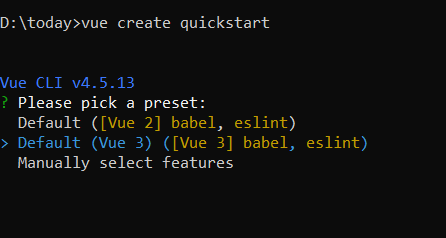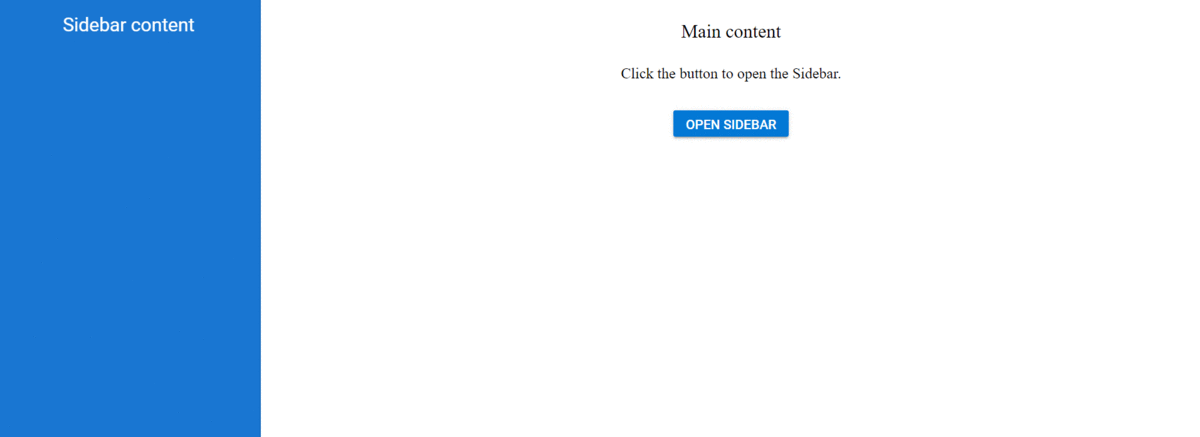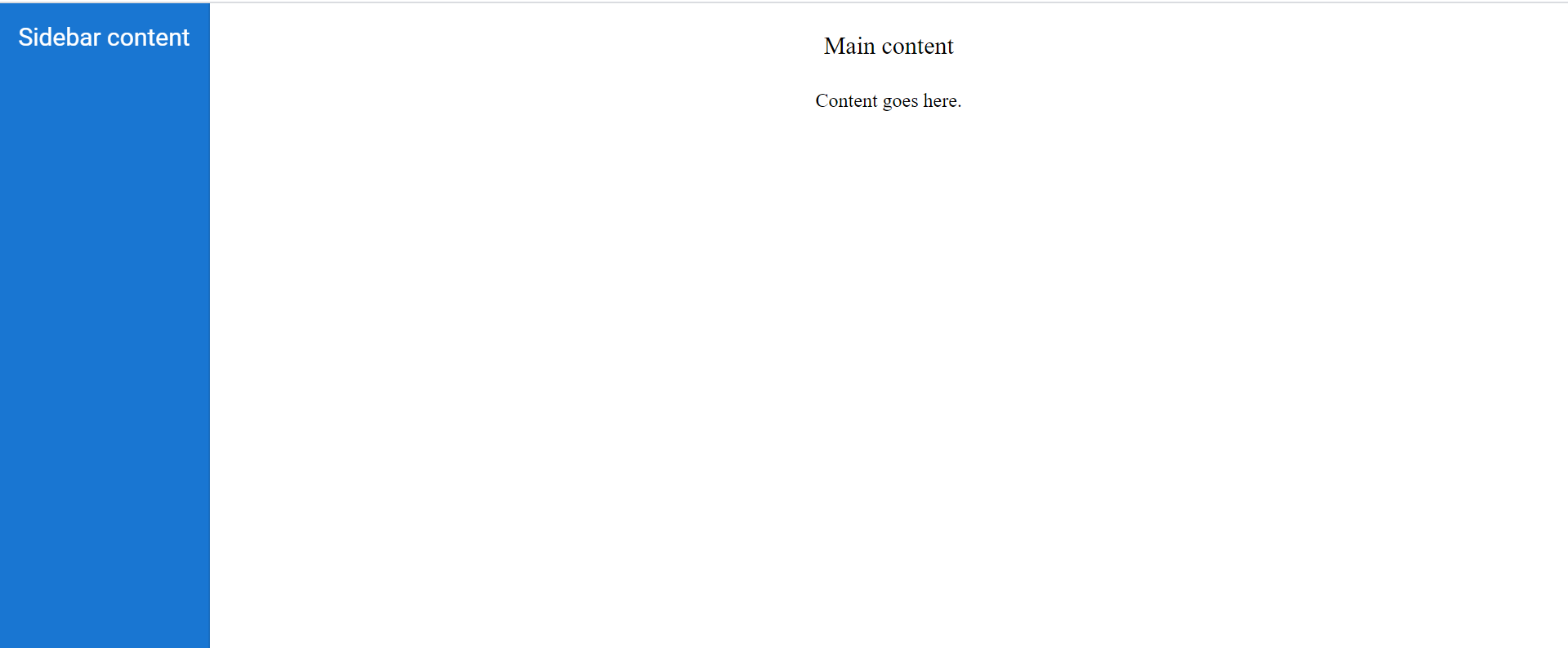- Prerequisites
- Creating Vue application using Vue CLI
- Adding Syncfusion Sidebar package in the application
- Adding CSS reference for Syncfusion Vue Sidebar component
- Adding Syncfusion Vue Sidebar component in the application
- Running the application
- Enable backdrop
- Position
- Animate
- Close on document click
- Enable gestures
Contact Support
Getting Started with Syncfusion Sidebar Component in Vue 3
28 Mar 202312 minutes to read
This section explains how to use Sidebar component in Vue 3 application.
Prerequisites
System requirements for Syncfusion Vue UI components
Creating Vue application using Vue CLI
The easiest way to create a Vue application is to use the Vue CLI. Vue CLI versions above 4.5.0 are mandatory for creating applications using Vue 3. Use the following command to uninstall older versions of the Vue CLI.
npm uninstall vue-cli -gUse the following commands to install the latest version of Vue CLI.
npm install -g @vue/cli
npm install -g @vue/cli-initCreate a new project using the command below.
vue create quickstartInitiating a new project prompts us to choose the type of project to be used for the current application. Select the option Default (Vue 3) from the menu.

Adding Syncfusion Sidebar package in the application
Syncfusion Vue packages are maintained in the npmjs.com registry.
The Sidebar component will be used in this example. To install it use the following command.
npm install @syncfusion/ej2-vue-navigations --saveAdding CSS reference for Syncfusion Vue Sidebar component
Import the needed CSS styles for the Sidebar component along with dependency styles in the <style> section of the src/App.vue file as follows.
<style>
@import "../node_modules/@syncfusion/ej2-base/styles/material.css";
@import "../node_modules/@syncfusion/ej2-vue-navigations/styles/material.css";
</style>
Adding Syncfusion Vue Sidebar component in the application
You have completed all the necessary configurations needed for rendering the Syncfusion Vue component. Now, you are going to add the Sidebar component using following steps.
-
Import the Sidebar component in the
<script>section of thesrc/App.vuefile.<script> import { SidebarComponent } from '@syncfusion/ej2-vue-navigations'; </script> -
Register the Sidebar component in
src/App.vuefile which are used in this example.import { SidebarComponent } from '@syncfusion/ej2-vue-navigations'; //Component registeration export default { name: "App", components: { 'ejs-sidebar' : SidebarComponent } }In the above code snippet, you have registered Sidebar component.
-
Add the component definition in template section.
<template> <div id="app"> <ejs-sidebar id="default-sidebar"> <div class="title"> Sidebar content</div> </ejs-sidebar> <div> <div class="title">Main content</div> <div class="sub-title">Content goes here.</div> </div> </div> </template> -
Summarizing the above steps, update the
src/App.vuefile with following code.<template> <div id="app"> <ejs-sidebar id="default-sidebar"> <div class="title"> Sidebar content</div> </ejs-sidebar> <div> <div class="title">Main content</div> <div class="sub-title">Content goes here.</div> </div> </div> </template> <script> import { SidebarComponent } from '@syncfusion/ej2-vue-navigations'; export default { name: 'App', components: { 'ejs-sidebar' : SidebarComponent } }; </script> <style> @import "../node_modules/@syncfusion/ej2-base/styles/material.css"; @import "../node_modules/@syncfusion/ej2-vue-navigations/styles/material.css"; #default-sidebar { background-color: rgb(25, 118, 210); color: #ffffff; } .title { text-align: center; font-size: 20px; padding: 15px; } .sub-title { text-align: center; font-size: 16px; padding: 10px; } </style>
Running the application
Run the application using the following command.
npm run serveWeb server will be initiated, Open the quick start app in the browser at port localhost:8080.
Enable backdrop
Enabling the showBackdrop in the Sidebar component will prevent the main content from user interactions, when it is in expanded state. Here, the DOM elements will not get changed. It only closes the main content by covering with a black backdrop overlay and focuses the Sidebar in the screen. Sidebar can be rendered with specific width by setting width property
In the following example, the showBackdrop and closeOnDocumentClick properties are enabled.
```
<template>
<div id="app">
<div class="wrapper">
<ejs-sidebar id="default-sidebar" :showBackdrop="showBackdrop" :closeOnDocumentClick="closeOnDocumentClick">
<div class="title"> Sidebar content</div>
</ejs-sidebar>
<div>
<div class="title">Main content</div>
</div>
</div>
</div>
</template>
<script>
import { SidebarComponent } from '@syncfusion/ej2-vue-navigations';
export default {
name: 'App',
components: {
'ejs-sidebar' : SidebarComponent
},
data () {
return {
showBackdrop :true,
closeOnDocumentClick:true,
}
}
};
</script>
<style>
@import "../node_modules/@syncfusion/ej2-base/styles/material.css";
@import "../node_modules/@syncfusion/ej2-vue-navigations/styles/material.css";
.title {
text-align: center;
font-size: 20px;
padding: 15px;
}
#default-sidebar {
background-color: rgb(25, 118, 210);
color: #ffffff;
}
</style>
```
You can get the following output while using above code blocks in Sidebar component.
Position
Positioning the Sidebar to the right or left of the main content can be achieved by using the position property. If the position is not set, the Sidebar will expand from the left to the body element. enablePersistence will persist the component’s state between page reloads. change event will be triggered when the state(expand/collapse) of the component is changed.
In the following example, the position property is set as Right.
```
<template>
<div id="app">
<div class="wrapper">
<ejs-sidebar id="default-sidebar" :position="position">
<div class="title"> Sidebar content</div>
</ejs-sidebar>
<div>
<div class="title">Main content</div>
</div>
</div>
</div>
</template>
<script>
import { SidebarComponent } from '@syncfusion/ej2-vue-navigations';
export default {
name: 'App',
components: {
'ejs-sidebar' : SidebarComponent
},
data () {
return {
position :'Right'
}
}
};
</script>
<style>
@import "../node_modules/@syncfusion/ej2-base/styles/material.css";
@import "../node_modules/@syncfusion/ej2-vue-navigations/styles/material.css";
.title {
text-align: center;
font-size: 20px;
padding: 15px;
}
#default-sidebar {
background-color: rgb(25, 118, 210);
color: #ffffff;
}
</style>
```
You can get the following output while using above code blocks in Sidebar component.
Animate
Animation transitions can be set while expanding or collapsing the Sidebar using the animate property. By default, animate property is set to true. enableRTL will display the sidebar in the right-to-left direction.
In the following example, the animate property is disabled.
```
<template>
<div id="app">
<div class="wrapper">
<ejs-sidebar id="default-sidebar" ref="sidebar" :type="type" :width="width" :animate="animate" :enableRtl="enableRtl">
<div class="title"> Sidebar content</div>
<div class="sub-title">
Click the button to close the Sidebar
</div>
<div class="center-align">
<ejs-button id="close" v-on:click="closeClick" class="e-btn close-btn">Close Sidebar</ejs-button>
</div>
</ejs-sidebar>
<div>
<div class="title">Main content</div>
<div class="sub-title"> Click the button to open/close the Sidebar.</div>
<div style="padding:20px" class="center-align">
<ejs-button id="toggle" class="e-btn e-info" v-on:click="toggleClick" >Toggle Sidebar</ejs-button>
</div>
</div>
</div>
</div>
</template>
<script>
import { SidebarComponent } from '@syncfusion/ej2-vue-navigations';
import { ButtonComponent } from '@syncfusion/ej2-vue-buttons';
export default {
name: 'App',
components: {
'ejs-sidebar' : SidebarComponent,
'ejs-button' : ButtonComponent
},
data () {
return {
animate:false,
enableRtl: true,
width:'280px',
type:'Push'
}
},
methods: {
toggleClick :function() {
this.$refs.sidebar.toggle();
},
closeClick: function() {
this.$refs.sidebar.hide();
}
}
};
</script>
<style>
@import "../node_modules/@syncfusion/ej2-base/styles/material.css";
@import "../node_modules/@syncfusion/ej2-buttons/styles/material.css";
@import "../node_modules/@syncfusion/ej2-vue-navigations/styles/material.css";
.center-align {
text-align: center;
padding: 20px;
}
.title {
text-align: center;
font-size: 20px;
padding: 15px;
}
.sub-title {
text-align: center;
font-size: 16px;
padding: 10px;
}
.center {
text-align: center;
display: none;
font-size: 13px;
font-weight: 400;
margin-top: 20px;
}
#default-sidebar {
background-color: rgb(25, 118, 210);
color: #ffffff;
}
.close-btn:hover {
color: #fafafa;
}
</style>
```
You can get the following output while using above code blocks in Sidebar component.

Close on document click
Sidebar can be closed on document click by setting closeOnDocumentClick to true. If this property is not set, the Sidebar will not close on document click since its default value is false. Sidebar can be kept opened during rendering using isOpen property.
In the following example, the closeOnDocumentClick property is enabled.
```
<template>
<div id="app">
<div class="wrapper">
<ejs-sidebar id="default-sidebar" ref="sidebar" :width="width" :type="type" :isOpen="isOpen" :closeOnDocumentClick="closeOnDocumentClick">
<div class="title"> Sidebar content</div>
</ejs-sidebar>
<div>
<div class="title">Main content</div>
<div class="sub-title"> Click the button to open the Sidebar.</div>
<div style="padding:20px" class="center-align">
<ejs-button id="toggle" class="e-btn e-info" v-on:click="toggleClick" >Open Sidebar</ejs-button>
</div>
</div>
</div>
</div>
</template>
<script>
import { SidebarComponent } from '@syncfusion/ej2-vue-navigations';
import { ButtonComponent } from '@syncfusion/ej2-vue-buttons';
export default {
name: 'App',
components: {
'ejs-sidebar' : SidebarComponent,
'ejs-button' : ButtonComponent
},
data () {
return {
closeOnDocumentClick: true,
isOpen:true,
type:'Push',
width:'280px'
}
},
methods: {
toggleClick :function() {
this.$refs.sidebar.toggle();
}
}
};
</script>
<style>
@import "../node_modules/@syncfusion/ej2-base/styles/material.css";
@import "../node_modules/@syncfusion/ej2-buttons/styles/material.css";
@import "../node_modules/@syncfusion/ej2-vue-navigations/styles/material.css";
.center-align {
text-align: center;
padding: 20px;
}
.title {
text-align: center;
font-size: 20px;
padding: 15px;
}
.sub-title {
text-align: center;
font-size: 16px;
padding: 10px;
}
.center {
text-align: center;
display: none;
font-size: 13px;
font-weight: 400;
margin-top: 20px;
}
#default-sidebar {
background-color: rgb(25, 118, 210);
color: #ffffff;
}
.close-btn:hover {
color: #fafafa;
}
</style>
```
You can get the following output while using above code blocks in Sidebar component.

Enable gestures
Expand or collapse the Sidebar while swiping in touch devices using enableGestures property. By default, enableGestures is set to true.
In the following example, the enableGestures property is enabled.
```
<template>
<div id="app">
<div class="wrapper">
<ejs-sidebar id="default-sidebar" ref="sidebar" :width="width" :type="type" :enableGestures="enableGestures">
<div class="title"> Sidebar content</div>
<div class="sub-title">
Click the button to close the Sidebar.
</div>
<div class="center-align">
<ejs-button id="close" v-on:click="closeClick" class="e-btn close-btn">Close Sidebar</ejs-button>
</div>
</ejs-sidebar>
<div>
<div class="title">Main content</div>
<div class="sub-title"> Click the button to open/close the Sidebar.</div>
<div style="padding:20px" class="center-align">
<ejs-button ejs-button id="toggle" class="e-btn e-info" v-on:click="toggleClick" >Toggle Sidebar</ejs-button>
</div>
</div>
</div>
</div>
</template>
<script>
import { SidebarComponent } from '@syncfusion/ej2-vue-navigations';
import { ButtonComponent } from '@syncfusion/ej2-vue-buttons';
export default {
name: 'App',
components: {
'ejs-sidebar' : SidebarComponent,
'ejs-button' : ButtonComponent
},
data () {
return {
enableGestures: false,
type:'Push',
width:'280px'
}
},
methods: {
toggleClick :function() {
this.$refs.sidebar.toggle();
},
closeClick: function() {
this.$refs.sidebar.hide();
}
}
};
</script>
<style>
@import "../node_modules/@syncfusion/ej2-base/styles/material.css";
@import "../node_modules/@syncfusion/ej2-buttons/styles/material.css";
@import "../node_modules/@syncfusion/ej2-vue-navigations/styles/material.css";
.center-align {
text-align: center;
padding: 20px;
}
.title {
text-align: center;
font-size: 20px;
padding: 15px;
}
.sub-title {
text-align: center;
font-size: 16px;
padding: 10px;
}
.center {
text-align: center;
display: none;
font-size: 13px;
font-weight: 400;
margin-top: 20px;
}
#default-sidebar {
background-color: rgb(25, 118, 210);
color: #ffffff;
}
.close-btn:hover {
color: #fafafa;
}
</style>
```
You can get the following output while using above code blocks in Sidebar component.



